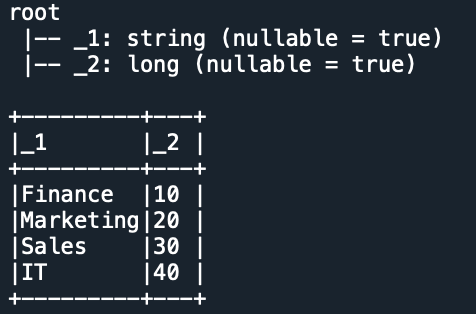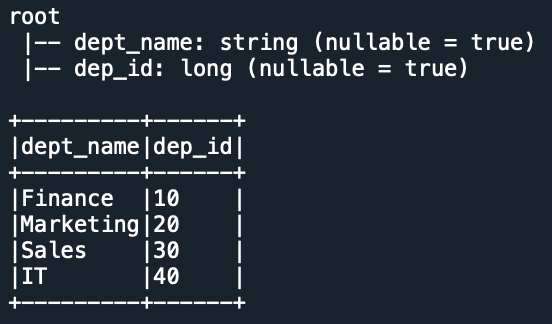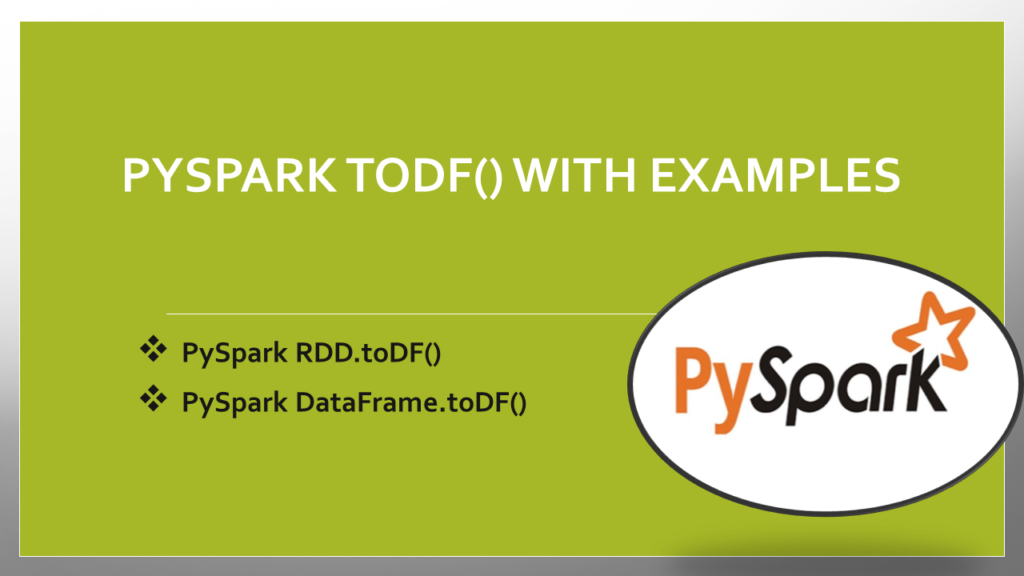The pyspark.sql.DataFrame.toDF() function is used to create the DataFrame with the specified column names it create DataFrame from RDD. Since RDD is schema-less without column names and data type, converting from RDD to DataFrame gives you default column names as _1, _2 and so on and data type as String. Use DataFrame printSchema() to print the schema to console.
Key Points of PySpark toDF()
- toDF() Returns a DataFrame
- The toDF() is present on both RDD and DataFrame data structures.
- The toDF(), by default, crates the column name as _1 and _2.
- toDF() also supports taking column names as a list or Schema as an argument.
1. PySpark RDD.toDF()
PySpark RDD toDF() has a signature that takes arguments to define column names of DataFrame as shown below. This function is used to set column names when your DataFrame contains the default names or change the column names of the entire Dataframe.
1.1 Syntax toDF()
Following is the Syntax of RDD.toDF()
# Syntax
toDF()
toDF(cols)
toDF(schema)
toDF(schema, sampleRatio)
1.2 toDF() Example
PySpark RDD contains different syntaxes of the toDF() function. Default function that doesn’t take the column names or Scheme returns a DataFrame with columns names _1, _2 _3 e.t.c
# Imports
from pyspark.sql import SparkSession
# Create SparkSession
spark = SparkSession.builder \
.appName('SparkByExamples.com') \
.getOrCreate()
# Create RDD
dept = [("Finance",10),("Marketing",20),("Sales",30),("IT",40)]
rdd = spark.sparkContext.parallelize(dept)
# Create DataFrame from RDD
df = rdd.toDF()
df.printSchema()
df.show(truncate=False)
Yields the below output. In the above example, first, we created the RDD and converted the RDD to the DataFrmae. By default, it creates column names as “_1” and “_2” as we have two columns for each row.

To assign the column names to the DataFrame use toDF() method with column names as arguments as shown below.
cols = ["dept_name","dep_id"]
dfFromRDD1 = rdd.toDF(cols)
dfFromRDD1.printSchema()
2. PySpark DataFrame.toDF()
PySpark toDF() has a signature that takes arguments to define column names of DataFrame as shown below. This function is used to set column names when your DataFrame contains the default names or change the column names of the entire Dataframe.
2.1 Syntax toDF()
Following is the syntax of DataFrame.toDF()
# Syntax of DataFrame toDF()
DataFrame.toDF(*cols)
2.2 toDF() Example
The below example adds column names to the DataFrame.
# Add column names to the DataFrame
cols = ["dept_name","dep_id"]
df = df.toDF(*cols)
df.printSchema()
df.show(truncate=False)
Yields below output.

3. Complete Example
Following is a complete example of the PySpark toDF() function of RDD and DataFrame.
# Imports
from pyspark.sql import SparkSession
# Create SparkSession
spark = SparkSession.builder \
.appName('SparkByExamples.com') \
.getOrCreate()
# Create RDD
dept = [("Finance",10),("Marketing",20),("Sales",30),("IT",40)]
rdd = spark.sparkContext.parallelize(dept)
# Create DataFrame from RDD
df = rdd.toDF()
df.printSchema()
df.show(truncate=False)
# Add column names to the DataFrame
cols = ["dept_name","dep_id"]
df = df.toDF(*cols)
df.printSchema()
df.show(truncate=False)
Conclusion
In this article, you have learned the PySpark toDF() function of DataFrame and RDD and how to create an RDD and convert an RDD to DataFrame by using the toDF() function.
Related Articles
- PySpark Broadcast Variable
- PySpark Broadcast Join
- PySpark between() range of values
- PySpark persist() Example
- PySpark lag() Function
- PySpark Random Sample with Example
- PySpark reduceByKey usage with example
- Pyspark – Get substring() from a column
- Show First Top N Rows in Spark | PySpark
- PySpark Create DataFrame from List
- PySpark Concatenate Columns
- PySpark Refer Column Name With Dot (.)
